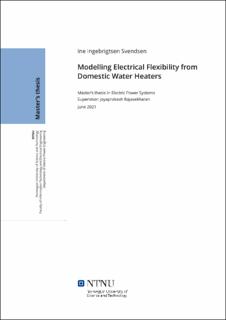| dc.contributor.advisor | Rajasekharan, Jayaprakash | |
| dc.contributor.author | Svendsen, Ine Ingebrigtsen | |
| dc.date.accessioned | 2022-04-17T17:20:22Z | |
| dc.date.available | 2022-04-17T17:20:22Z | |
| dc.date.issued | 2021 | |
| dc.identifier | no.ntnu:inspera:79771761:20917737 | |
| dc.identifier.uri | https://hdl.handle.net/11250/2991200 | |
| dc.description.abstract | Elektriske varmtvannsberedere (EVB-er) har fått mye oppmerksomhet i akademiske studier på grunn av deres utmerkede termiske kapasitet, høye effekt og raske responstid. Dette gjør dem til en bra kilde for fleksibilitet til strømnettet, som for eksempel flytting av last og frekvenskontroll. Mange forskere har sett på store populasjoner av EVB-er i husholdninger når de studerer fleksibilitetspotensialet, mens det kan forskes mye mer på mindre populasjoner der man tar hensyn til den diskrete oppførselen til EVB-ene. Derfor vil denne oppgaven utforske oppførselen og estimere fleksibilitetspotensialet til en liten gruppe EVBer, både på et aggregert og individuelt nivå ved å bruke forskjellige kontroll- og gjenkoblingsstrategier.
Høyefrekvens temperatur- og effektmålinger på en EVB på det Nasjonale Smart Grid Laboratoriet har blitt brukt til å lage forskjellige modeller av en EVB. Den enkleste modellen ble valgt for å simulere EVB-en, siden denne passet bra med de målte eksperimentene gjort på laberatoriet, og temperaturen avvek med maksimalt 8%. Modellen ble brukt sammen med en modell som simulerer vannforbruksdata for å lage en liten populasjon av EVB-er, og fleksibilitetspotensialet var estimert ved å bruke to forskjellige kontrollstrategier: aktivitetskontroll og temperaturkontroll.
På tross av mangelen på norske vannforbruksdata traff den simulerte aggregerte effektprofilen, laget med svenske vannforbruksdata, bra sammenliknet med effektmålinger gjort på EVB-er i Norge. De samme morgen- og ettermiddagstoppene ble observert, og amplitudene på lasttoppene stemte bra overens.
Populasjonen av EVB-er har et stort potensial til å flytte lasten sin, og totalt 7 kWh ble flyttet til et annet tidspunkt uten at komforten til forbrukerene ble påvirket. Resultatene gir en detaljert oversikt over oppførselen og fleksibiliteten til den enkelte EVB-en i tillegg til den aggregerte fleksibiliteten. Gjenkoblingen av EVB-ene er kritisk, og den foreslåtte strategien for gjenkobling virket utmerket slik at all last forbrukt en time, kunne bli flyttet uten å forårsake en større effekttopp etter gjenkobling.
Temperaturkontroll er foretrukket over aktivitetskontroll, siden mer last kan flyttes og de maksimale effekttoppene etter gjenkobling er mindre. I tillegg er denne strategien mindre sensitiv til feil i predikert varmtvannsforbruk. | |
| dc.description.abstract | Electric water heaters (EWHs) have gained a lot of attention in academic research because of their excellent thermal capacity, high rated power and fast response time, making them a great source of flexibility to provide grid services, such as load shifting and frequency control. Many researchers have looked into large populations of residential EWHs when studying the flexibility potential, leaving much to be studied on smaller populations, taking into consideration the discreteness of their behaviour. Therefore, the objective of this master thesis is to explore the behaviour and estimate the flexibility potential of a small scale population of EWHs, both on an individual and aggregated level, by using different control and reconnection strategies.
High frequency power and temperature measurements of an EWH at the National smart grid laboratory were used to create different models of an EWH. The simplest model was chosen to simulate the EWHs, since it matched well with the experiments done at the laboratory, with the temperature differing by at most 8%. The model was used together with a water consumption behaviour model to simulate a small population of EWHs, and the flexibility potential was estimated using two different controls techniques: activity and temperature control.
Despite the lack of Norwegian water consumption measurements, the simulated aggregated power profile performed very well with Swedish time-of-use data when comparing it to power measurements from EWHs in Norway. The same trend of morning and afternoon peaks could be observed, and the amplitude of the peaks matched reasonably well.
The aggregation of EWHs has a large potential for load shifting, and up to 7 kWh was successfully shifted to a later time without affecting consumer comfort. The results provide a detailed overview of both the behaviour and flexibility of the individual EWHs, as well as the aggregated flexibility. It is found that the reconnection of the EWHs is critical, and the proposed strategy for reconnection performed excellently by shifting all consumption during one hour without increasing the maximum instantaneous power consumption after reconnection.
The temperature control strategy is preferred over the activity control, since it can shift more energy and still cause smaller peaks in power consumption. In addition, this strategy is less sensitive to errors in predicted hot water usage. | |
| dc.language | eng | |
| dc.publisher | NTNU | |
| dc.title | Modelling Electrical Flexibility from Domestic Water Heaters | |
| dc.type | Master thesis | |
